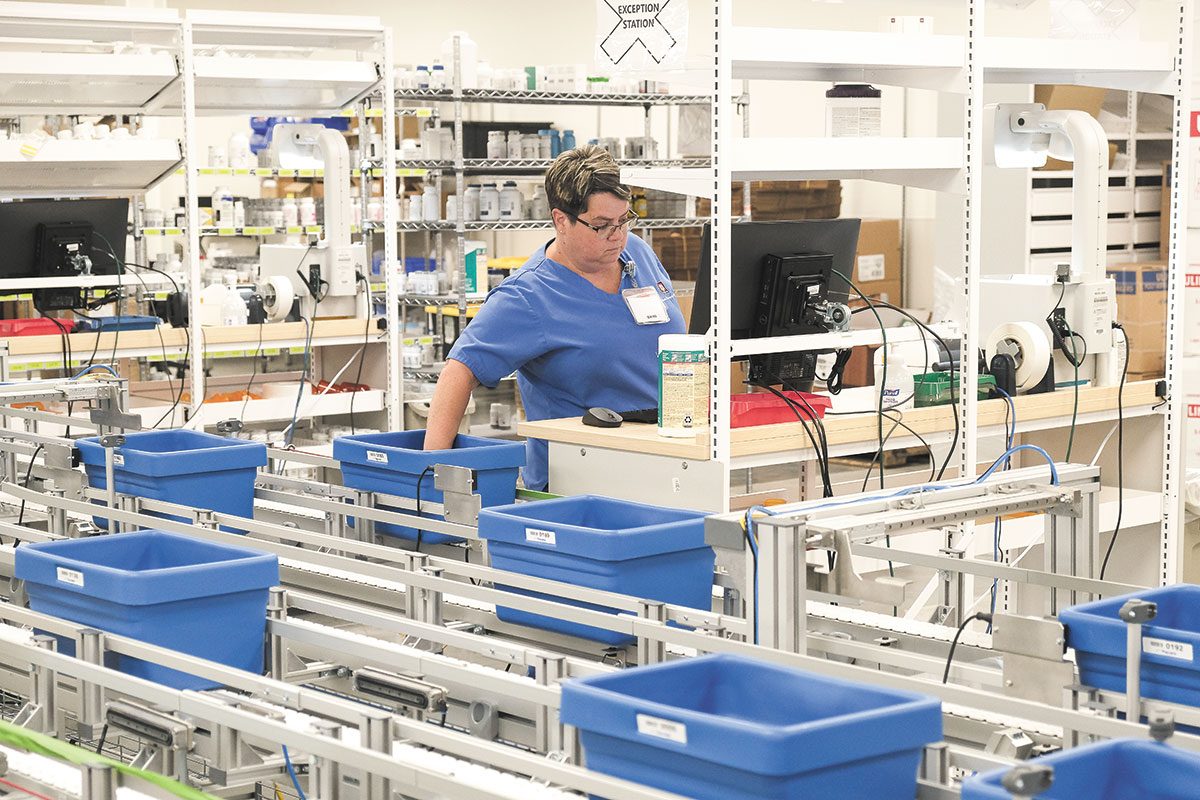Subscriber Benefit
As a subscriber you can listen to articles at work, in the car, or while you work out. Subscribe Now
It’s nearly as big as 15 basketball courts placed end to end and is stacked with thousands of medications, from anxiety pills to cancer treatments.
But it’s not a corner drugstore and doesn’t take any walk-in business. It’s Indiana University Health’s new pharmacy hub and distribution center in Plainfield—stretching 70,000 square feet—with enough pills, lotions, and infusible and injectable drugs under one roof to supply its 16 hospitals and hundreds of clinics for weeks.
The Indianapolis-based hospital system is hoping the pharmacy hub, which opened this summer, will help it reduce the cost of providing pharmaceutics to patients and its insurance-plan members by centralizing and standardizing its pharmacy supply chain. It did not say how much prices might drop.
Many hospitals sharply mark up the price of drugs, especially specialty drugs to treat patients with cancer, vision loss, low white-blood-cell count and other serious diseases. Across the country, hospitals routinely mark up prices on drugs an average of 250%—and some more than 500%, according to a 2021 study by Sanford Bernstein.
IU Health said it is “committed to making essential medications more accessible and affordable.” It added that it offers financial counseling to patients to connect them to discounted medications, which resulted in patient savings of more than $100 million last year.
The health care system said its new pharmacy hub also will allow it to pass along efficiencies and drug savings to patients. The purchase of larger quantities of drugs also will be possible, preventing shortages that could keep patients from sticking to their medication orders.

“We knew we were seeing soaring pharmaceutical costs, and we know there has been a shortage of pharmaceutical drugs,” said Buck Stanford, vice president and chief pharmacy officer at IU Health. “And we knew it was a problem that wasn’t going away anytime soon.”
Ramping up
The facility cost more than $30 million to build and equip. The hospital system said it expects to recoup that cost through savings and efficiencies over five to 10 years.
The goal is to allow IU Health, the largest hospital system in Indiana, to get more control over its drug supplies and costs. The system spends hundreds of millions of dollars a year on pharmaceuticals, making it one of its top expenses, along with wages, benefits and other supplies.
It has been ramping up the huge operation for months and recently held an open house. It’s the largest central pharmacy for a hospital system in Indiana, with about 85 workers. It plans to expand that to about 180 within three years.
Across the United States, nearly half of all hospital systems were considering setting up centralized distribution, attracted by the potential of greater savings and supply-chain control, according to a 2019 survey by Swisslog Healthcare.
In recent years, some large U.S. hospital systems have moved in this direction. Last year, Baptist Health spent $40 million to build a 90,000-square-foot pharmacy hub in LaGrange, Kentucky, to serve its nine hospitals in Kentucky and southern Indiana. In 2021, Ascension, the St. Louis-based Catholic health care giant, spent $8 million to build a 30,000-square-foot pharmacy hub in Austin, Texas.

“The pharmacy is an ecosystem,” Scott Spille, pharmacy operating officer for Ascension Rx, told the Austin American-Stateman when the hub opened in June 2021. “It doesn’t just start and stop.”
Some pharmacy experts applaud IU Health and other health systems that are centralizing their pharmacy operations. They say it improves efficiency and patient safety.
“When you’re putting your distribution in a centralized facility, you’re able to have the staff there focus more on ensuring it’s the right drug, it’s made correctly,” said Veronica Vernon, assistant professor of pharmacy practice at Butler University and past president of the Indiana Pharmacy Association. “And so centralisized facilities actually improve patient safety in regards to reducing medication errors.”
A growing trend
It’s unclear whether any other hospital system in central Indiana is considering a similar move. Franciscan Health Indianapolis declined to comment, and Ascension St. Vincent did not respond.
Community Health Network said it has “centralized inventory” for its six hospitals and scores of clinics at its East Hospital campus on North Ritter Avenue.
The hospital system did not provide the square footage of the facility but said it’s not a warehouse.

“It’s a big storage room,” said Dawn Moore, Community’s chief pharmacy officer. “We have a separate area for that purpose. It’s not like our hospital operations pharmacy. It’s a separate location where we conduct that service.”
She added that huge pharmacy hubs are expensive and that hospital systems need to analyze in depth to make sure they pay off.
“You don’t centralize just to centralize because you can,” Moore said. “The return on investment needs to be good—and not just for making money, but what are the savings? Or what efficiencies are you going to realize?”
Meanwhile, national online and mail-order services, such as Amazon, are pushing into the nation’s $400 billion pharmacy market. Five years ago, Amazon bought PillPack, an online pharmacy that fills prescriptions and ships drugs packaged in presorted doses. Amazon has used the PillPack acquisition to get a foothold in the industry—and build on it.
Huge pharmacy distribution centers are nothing new. St. Louis-based Express Scripts operates a 340,000-square-foot pharmacy distribution center in Whitestown. The company became the largest mail-order distributor when it bought Medco Health Solutions Inc. in 2012.
IU Health’s pharmacy hub, though it is cavernous, is not a freestanding building. The health system carved the space out of its existing, 300,000-square-foot supply warehouse, called an “integrated service center,” near the Indianapolis International Airport.
IU Health opened the warehouse in 2018 in an effort to standardize inventory and order in bulk at a discount.
The pharmacy section of the massive building is equipped with multiple layers of security, including a guard at the door and badge access to offices and rooms.

Increasing capacity
A centerpiece to the operation is a central line that fills up to 5,000 prescriptions in an eight-hour shift, including labeling and counting all pill orders. Many of the orders are then delivered directly to patients’ homes or to the hospitals’ retail pharmacies.
Previously, all prescription orders were filled by hand, at a pace of only 1,000 prescriptions per eight-hour shift, IU Health said. In the large room, a series of long conveyor belts shuttled blue plastic totes, while a series of robots grabbed medicines from bins or shelves. A group of pharmacists and pharmacy technicians monitored the process.
On a recent day, the central fill line was operating at low volume, but officials said they expected it to pick up as soon as the operation went into high gear.
“I haven’t really seen this thing be able to really flex its muscles, but August will be impressive to see what it can do,” said Shelby Koonce, a central fill pharmacist with IU Health.
Another major feature of the pharmacy hub is a robotic drug storage system designed to store, retrieve and control inventory. Molly Green, manager of distribution operations, demonstrated by tapping the name of a drug onto a touch screen at her station. In the stacks, a robot with long extension arms reached more than 15 feet high to retrieve the drugs and drop them into a drawer at waist level.
“The nice thing about this is, I’m not walking around all over the place trying to gather things,” Green said, as she opened the drawer and inspected a small box of medications inside.
IU Health is already talking about using drones to make selected deliveries or to get supplies from one location to another.
“It’s on our road map,” Stanford said. “I would say for us truly using drones, we’re probably three or four years out.”
The IU Health pharmacy hub is designed to free pharmacists and pharmacy technicians to spend more time in direct patient care, relieving them of doing repetitive “production work,” such as compounding.
All 16 IU Health hospitals will continue to have pharmacies in house, but some of them might get smaller as inventory is centralized at the hub.
Stanford said the pharmacy hub has been in the planning stages for nearly three years. Construction began during the pandemic and recently was completed.
The facility will support pharmaceutical purchasing, as well as distribution for all hospitals and clinics, urgent care centers, home health, home infusion, and retail and inpatient pharmacies.
Already, IU Health said, it has chalked up some wins. In the pharmacy hub’s compounding center, where pharmacy technicians mix ingredients together to create a medication tailored to a patient’s needs, workers were able to fill an urgent special order of a drug for a young patient at Riley Hospital for Children within a few hours.
IU Health was also able to buy drugs in larger bulk quantities through the hub, including an antibiotic frequently used by doctors and nurses that the system previously bought as it needed.
“We were able to do some forecasting of what we would need over the next six to 12 months,” Stanford said. “We were able to save about 50% of what would have been the per-unit cost.”•
Please enable JavaScript to view this content.

